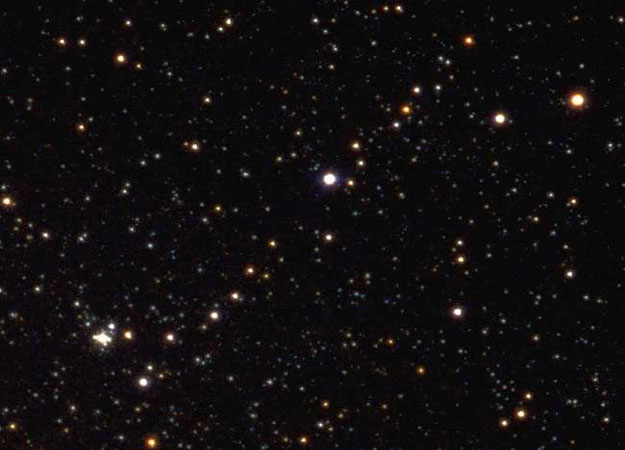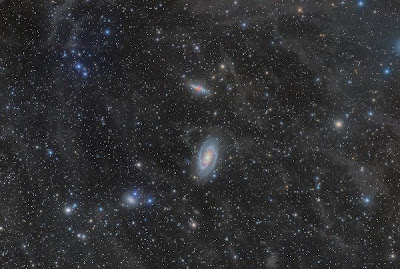http://www.wired.com/science/space/news/2007/05/liquid_telescope wrote:
A Plan to Build a Giant Liquid Telescope on the Moon
Alexander Gelfand Email 05.21.07
Even by astronomical standards, Roger Angel thinks big. Angel, a leading astronomer at the University of Arizona, is proposing an enormous liquid-mirror telescope on the moon that could be hundreds of times more sensitive than the Hubble Space Telescope.
Using a rotating dish of reflective liquid as its primary mirror, Angel's telescope would the largest ever built, and would permit astronomers to study the oldest and most distant objects in the universe, including the very first stars.
"It's an idea that's been around, and we decided to flesh it out," Angel says.
Angel, a member of the National Academy of Sciences, a MacArthur Fellow and a Fellow of the Royal Society, is currently concluding a study to determine the feasibility of constructing a lunar liquid mirror telescope, or LMT, for NASA Institute for Advanced Concepts, an NASA-funded space think tank.
LMT's have been built on Earth -- the Large Zenith Telescope in British Columbia is the third largest telescope in North America -- but the moon's low gravity and lack of atmosphere would allow for a truly gigantic instrument.
Angel dreams of a 100-meter mirror, which would be larger than two side-by-side football fields and would collect 1,736 times more light than the Hubble.
Even a 20-meter instrument, which is more likely in the near term, would be 70 times more sensitive than the Hubble and could detect objects 100 times fainter than those that will be seen with the James Webb Space Telescope, a next-generation orbiting observatory scheduled for launch in 2013.
"At first, it sort of sounds like a crazy idea," says Paul Hickson of the University of British Columbia, one of two Canadian LMT experts who collaborated with Angel on the study. "But when you go through it in some detail, you realize it could actually work."
NIAC director Bob Cassanova agrees. "It's quite feasible," he says. "The debate about this is about some of the details." The biggest advantage is the relative low cost. Liquid telescopes cost 10 to 20 times less to build than polished aluminum mirrors of similar size, in part because they needn't be engineered to the same tolerances. And even the largest liquid mirrors don't require the sophisticated support structures that are needed to prevent solid ones from sagging under their own weight. "The forces of nature conspire to give them the right shape," Borra says.
Although the final cost of the project is yet to be determined, a 20-meter lunar LMT ought to be a bargain in comparison to the James Webb Space Telescope, which is expected to carry a $4.5 billion price tag. It would also make the JWST look like a child's spyglass. "There's very good science to be done, and you're not going to make a telescope of that size and sensitivity in space without spending an ungodly sum of money," Angel says.
There are many advantages to building a deep-space telescope on the moon. A lunar LMT would be free from the atmospheric distortion that afflicts terrestrial telescopes of all kinds, and from the self-generated winds that produce troublesome waves in the largest earth-based LMTs.
The light from the universe's most distant stars is intensely red-shifted, and the airless lunar deep-freeze would be ideal for infrared observation – as would a liquid mirror: While they perform as well as conventional mirrors at visible wavelengths, liquid mirrors do even better in the infrared.
Alas, the same low temperatures that would facilitate infrared observation would also turn mercury, the liquid used in terrestrial LMTs, into a solid. So the greatest technical challenge for Angel's team lies in finding reflective liquids with low freezing points and vapor pressures – liquids that would neither freeze nor evaporate into space.
That task fell to Ermanno Borra, a physicist and liquid-mirror pioneer at Laval University in Quebec who first made the case for a lunar LMT in 1991. Recently, Borra has been experimenting with metal liquid-like films, or MELFFs, that reflect light as effectively as aluminum. Borra declined to comment on his results until they've been published in the journal Nature later this summer. But his teammates were impressed. "It looks very promising," Hickson says.
Borra's MELFFs are new, but liquid mirrors have been around for a while. Sir Isaac Newton first recognized that gravity and centrifugal force would cause a rotating liquid to assume a parabolic shape. In 1850, Italian astronomer Ernesto Capocci suggested that a spinning dish of mercury could serve as the primary mirror in a telescope. And the American physicist Robert W. Wood built several working mercury-mirror telescopes in the early 1900s.
Still, the earliest LMTs were beset with problems. They couldn't maintain stable rotation speeds, and their crude bearings caused the mirrors to vibrate. And since liquid mirrors cannot be tilted in order to track objects as they move across the sky, early efforts at liquid-mirror astrophotography generated streaks of light that quickly exited the field of view. (While fixed pointing precludes some kinds of astronomical work, it doesn't interfere with studies of the most distant stars and galaxies. thanks to the homogeneous and isotropropic nature of the universe, these objects are found wherever one might look.)
In recent years, however, Borra and Hickson have overcome these obstacles.
Ultra-smooth air bearings and synchronous motors governed by crystal oscillators and optical sensors eliminated the vibration and unstable rotation that plagued early LMTs. (Air bearings wouldn't work on the moon, so Angel proposes using superconductor magnetic bearings instead.)
The tracking problem was solved with a technique called drift-scanning, in the rotation of the moon is taken into account by software. Digitization also allows images from many nights' observation to be combined, resulting in extremely long cumulative exposure times.
With Borra's help, Hickson built the Large Zenith Telescope , a 6-meter LMT that is now the third largest telescope in North America. Hickson is currently working on a plan to build an 8-meter instrument in Chile.
A relatively small lunar LMT could be deployed robotically, its rotating dish unfurling like an umbrella. But building a 20-meter or 100-meter instrument would require human hands.>>



